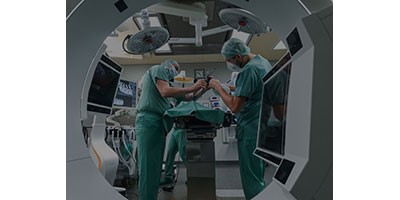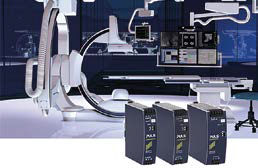The healthcare industry is going through a period of dramatic change. We are seeing more and more digital solutions throughout the patient journey, at every stage, from prevention and diagnosis to treatment. Medicine 4.0 can only work on the basis of collaborative efforts at the point where the medical and engineering disciplines overlap. Therefore, we are proud to present the Electronic Medical Electronics Conference (eMEC) as the perfect platform for this interdisciplinary partnership. It will take place for the first time on November 15, 2018, with an innovative event and space concept.
Electronics is at the heart of innovations within the medical technology sector. There are already many examples of vital developments from the past, such as X-ray machines and pacemakers. And now, as healthcare becomes increasingly digitized with networking, smart data analytics, and telemedicine, electronics have become an integral part. The result of this is further market growth, which is driven by aging and growing global populations, as well as a greater focus on individualization within medicine. On that basis, Global Market Insights anticipates that the international market for electronic medical products will generate sales of USD 148 billion by the year 2024, with a compound annual growth rate (CAGR) of 12 percent. Based on markets and markets, IoT medical device turnover is expected to be just under $64 billion by 2023, at a CAGR of 25 percent.
The same analysts also forecast just over USD 132 billion for the global e-health market by 2023. However, all this opportunity is outweighed by a host of risks that should not be underestimated. For example, market concentration will continue to increase along with competition from emerging markets. Not to mention, big IT companies from outside the industry (such as Google and Apple) are poised to move into the healthcare first market as many future innovations will be data and software based. In addition, regulatory requirements surrounding market and product approval, such as the amended EU Medical Device Regulation, slow growth and create considerable costs. And then there are the serious security risks associated with online networks (IoT).
All of these topics will be covered at the first ever Medical Electronics Conference (eMeC) and the Medical Electronics Forum on electronics. electronica Medical Electronics Conference (eMEC): the debut In 2018, the focus will be on medical electronics for the first time when the field has its own dedicated conference (November 15, ICM-Internationales Congress Center München). The event will see doctors and electronic engineers enter into discussions about the future of the medical sector. Topics covered will include smart medical devices, cloud computing, data security and sovereignty, blockchain technology, collaborative robots, smart contracts, usability, artificial intelligence, telemedicine, and Medicine 4.0. Alongside traditional speeches and presentations, the Electronic Medical Electronics Conference (eMEC) will also open the stage to innovative discussion formats to foster interdisciplinary dialogue: Podium discussions encourage the audience to actively participate, providing the ideal platform for a controversial but results-driven exchange.
Open space discussions are in-depth discussions that take place in small groups. There is no script to follow and the process and results are left open until the end. “Dating a problem” is the name given to sessions where doctors and electronics engineers discuss problems at length on site and propose solutions together. “Pros and Cons” sessions involve two people going head to head in front of an audience. Who will have the strongest arguments? It is up to the audience to decide by voting electronically.
Medical Electronics Forum: All Things Wearable
The focus of the Medical Electronics Forum (Hall C3, Stand 534 on the morning of November 16) is on wearables. After all, they are expected to have a huge impact on the healthcare and medical treatment sector. Once connected to the Internet, they allow doctors to monitor the health of their patients remotely and provide ongoing care to people with chronic illnesses. Older people will also be able to live independent lives in familiar surroundings for longer thanks to wearables. Furthermore, intelligent analysis of the data will allow the healthcare system to be further optimized.
Medical electronics: the exhibitors
Medical products and services can be found primarily in the exhibition areas covering embedded systems, sensors, printed circuit boards and other bare circuit carriers, wireless technology, power supplies, and micro and nano systems. MEMS market leader Bosch Sensortec (Hall C3, Stand 522) will be exhibiting a range of sensors for portable applications that constantly measure vital parameters. Analog Devices (Hall C4, Stand 111) will feature implantable MEMS inertial sensors that consume very little power and can be used to monitor patients at higher risk of falling, for example. The world's smallest differential pressure sensor from Sensirion (Hall B3, Stand 417) plays a crucial role in cutting-edge therapy in smart inhalers. Mektec (Hall B4, Stand 530) produces flexible printed circuit boards that are essential for medical devices. Manufactured in clean rooms, they are extremely thin, lightweight and durable. Thanks to Fraunhofer IMS's microsensor system (Hall C3, Stand 409), glaucoma patients can measure their intraocular pressure and temperature via an implanted sensor without the need for any contact. The Heinz Nixdorf Chair for Biomedical Electronics (Hall B5, Stand 450) is the first port of call for the development of customized solutions in telemedicine, as well as for lab-ona-chip devices. The Hahn Schickard Association (Hall A1, Stand 443) has developed a high-tech screwdriver with built-in sensors for the medical process of distraction osteogenesis, which allows patients to adjust the settings themselves.








